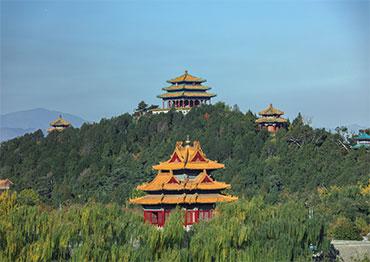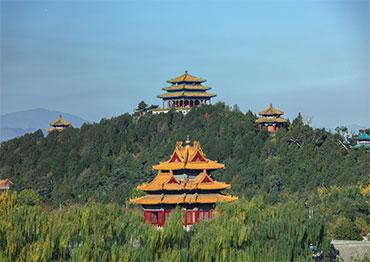Standing at the center of the Axis, it served as a royal garden for the Yuan, Ming and Qing dynasties.
Standing at the center of the Axis, it served as a royal garden for the Yuan, Ming and Qing dynasties. Wanchun Pavilion was the highest place during that period and provides a panoramic view of the Axis. Each of the five pavilions, including Wanchun, hosts a copper Buddha symbolising the five tastes: acid, spicy, bitter, sweet and salty. The last emperor of the Ming Dynasty Chongzhen hanged himself from a locust tree in the park in 1644.
The altar was built for emperors to perform rites for the harvest. The altar is square, which represents Earth. The upper level of the altar contains five different colors of soil, which were sourced from different parts of the country to symbolize unity.
The Forbidden City is listed by UNESCO as the largest collection of preserved ancient wooden structures in the world. The layout and spatial arrangement features a central axis, symmetrical design and layout of outer court at the front and inner court at the rear, and additional landscaped courtyards.
Initially built in 1420, Ming and Qing emperors offered sacrifices here to the gods of agriculture and nature, including the gods of storms, rain, mountains and seas, to pray for a good climate and a good harvest. They worked on a royal farm there during the ritual to show the great importance they attached to agriculture.
The single-span arch bridge made of white marble was the northernmost floodgate of the Grand Canal during the Yuan Dynasty. Four stone magical beasts, which look like a mix of tigers, lions and dragons, crouch at the four ends of the bridge, defending the water against flood or drought.
Yongding Men (Gate of Perpetual Stability)
The southern terminal of the Beijing Axis, it was first built in 1553 and demolished in 1950s. The tower on the gate was rebuilt in 2005. Its original appearance is recorded on the Kangxi Emperor’s Southern Inspection Tour, a painting completed in 1693. In one of the scrolls, the emperor leaves Beijing through this gate.
The northern terminal of the Beijing Axis, they told people in downtown Beijing the time every two hours from 7pm to 5am during the Yuan, Ming and Qing dynasties. The sound of the 25 drums came first in the evening, ended by the sound of the giant copper bell in the morning.
Tian’an Men (Gate of Heavenly Peace)
Initially called Chengtian Gate when it was built in 1420, it means imperial power was granted by Heaven. Walking across the five white marble bridges inside the gate lead to Taihe Gate (Gate of Supreme Harmony), where Ming and Qing emperors met officials or were enthroned sometimes.
Mao Zedong Memorial Hall is on the south side of the Tian’anmen Square. This Hall is divided into three halls and Mao’s body lies in a crystal coffin in one of the halls surrounded by fresh bouquets of various famous flowers and grasses.
“It is the most complete existing imperial sacrificial building complex in China and the world’s largest existing building complex for offering sacrifices to heaven,” according to the UNESCO World Heritage description. In ancient China, emperors were regarded as “the sons of heaven,” and they prayed for good harvests there.
Imperial Ancestral Temple
It is located to the east of Tian’an Men, and served as the place where Ming and Qing emperors offered sacrifices to their ancestors. Memorial tablets of a few officials were kept there, the highest honor an ancient official could have.
Once a small closed imperial square inaccessible to ordinary people during the Ming and Qing dynasties, it has turned into the present grand square covering an area of 440,000 square meters. It can hold huge gatherings of one million people.
Monument to the People’s Heroes
The granite Monument to the People’s Heroes is at the heart of Tiananmen Square. Built in 1952, it is one of the tallest monuments in China’s modern history.
Zhengyang Men (Gate of the Zenith Sun)
It was a defense architecture system composed of three parts: the city gate tower, the watchtower and the inner defensive courtyard. The city gate tower and the watchtower are well preserved. On the bustling business street to the south of the gate are many well-established brands with hundreds of years of history, including Quanjude Roast Duck restaurant.

 Old Version
Old Version













